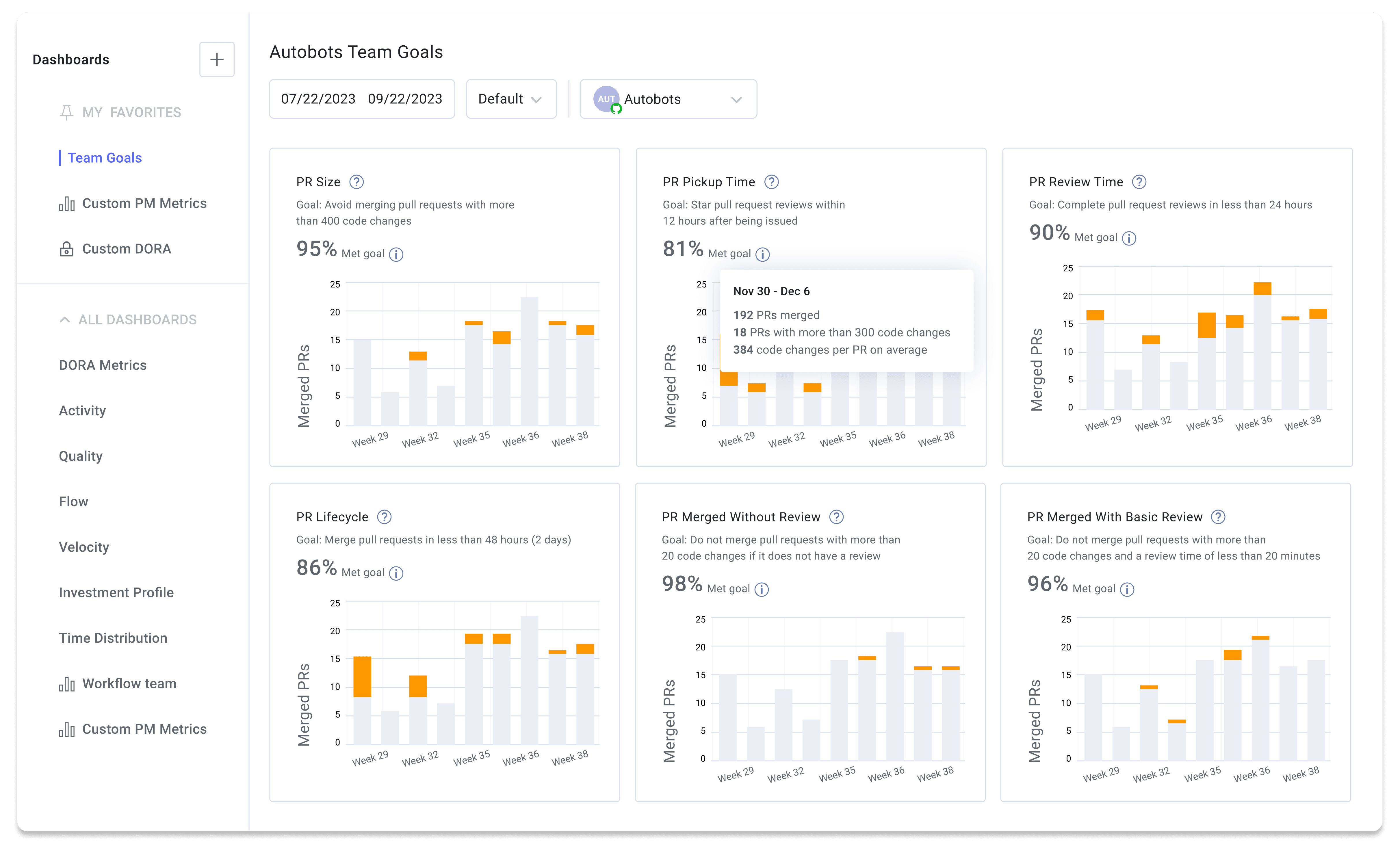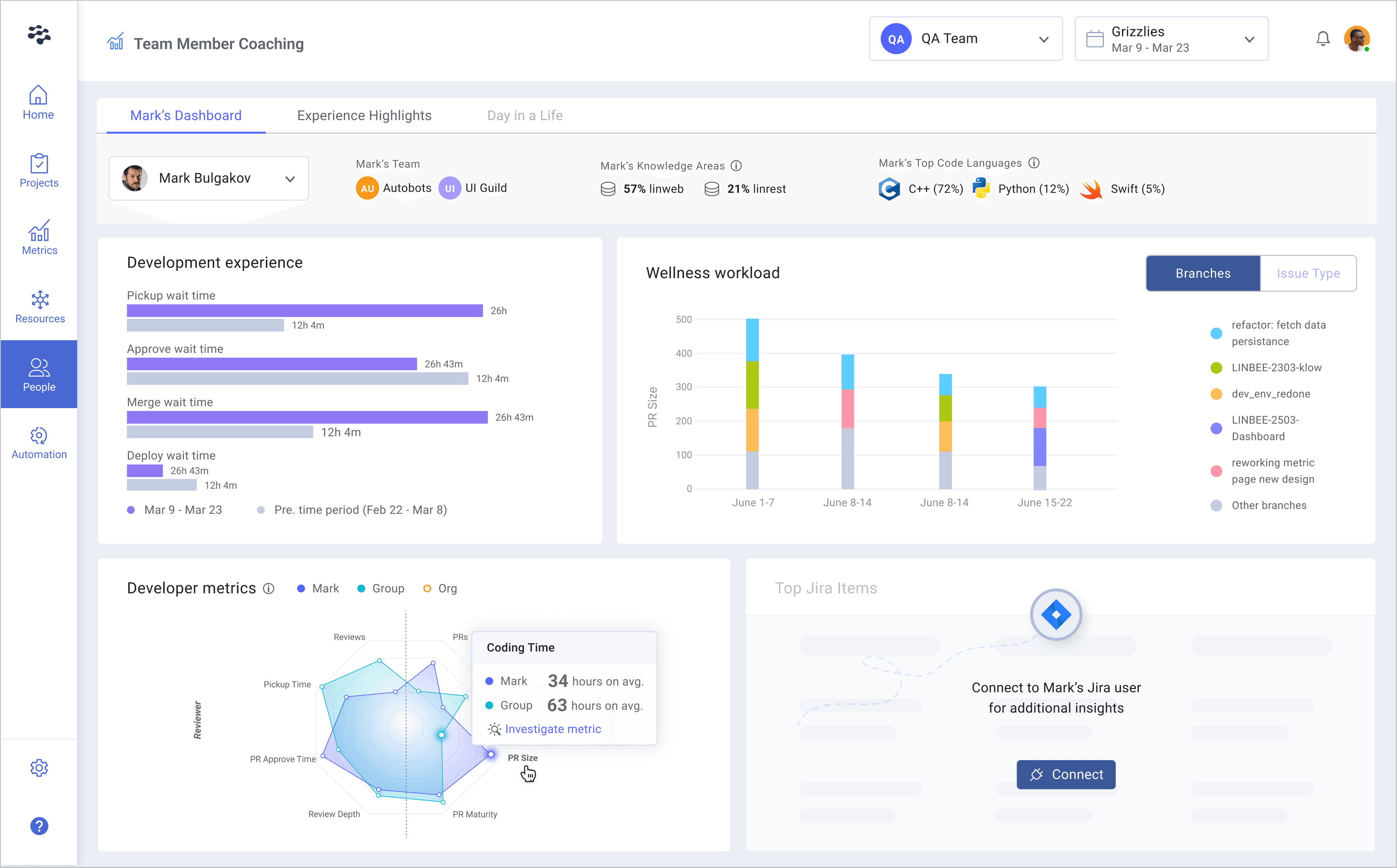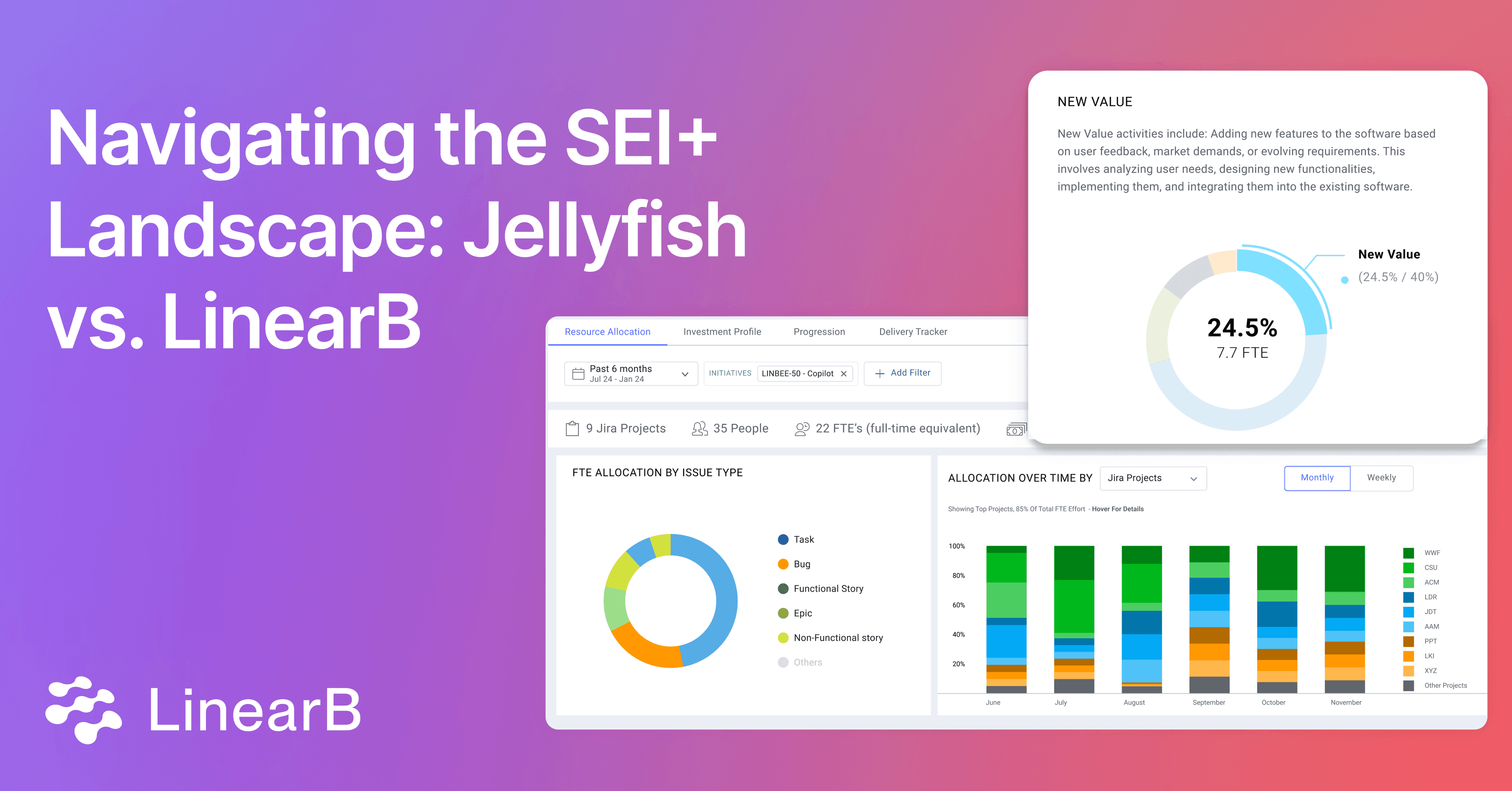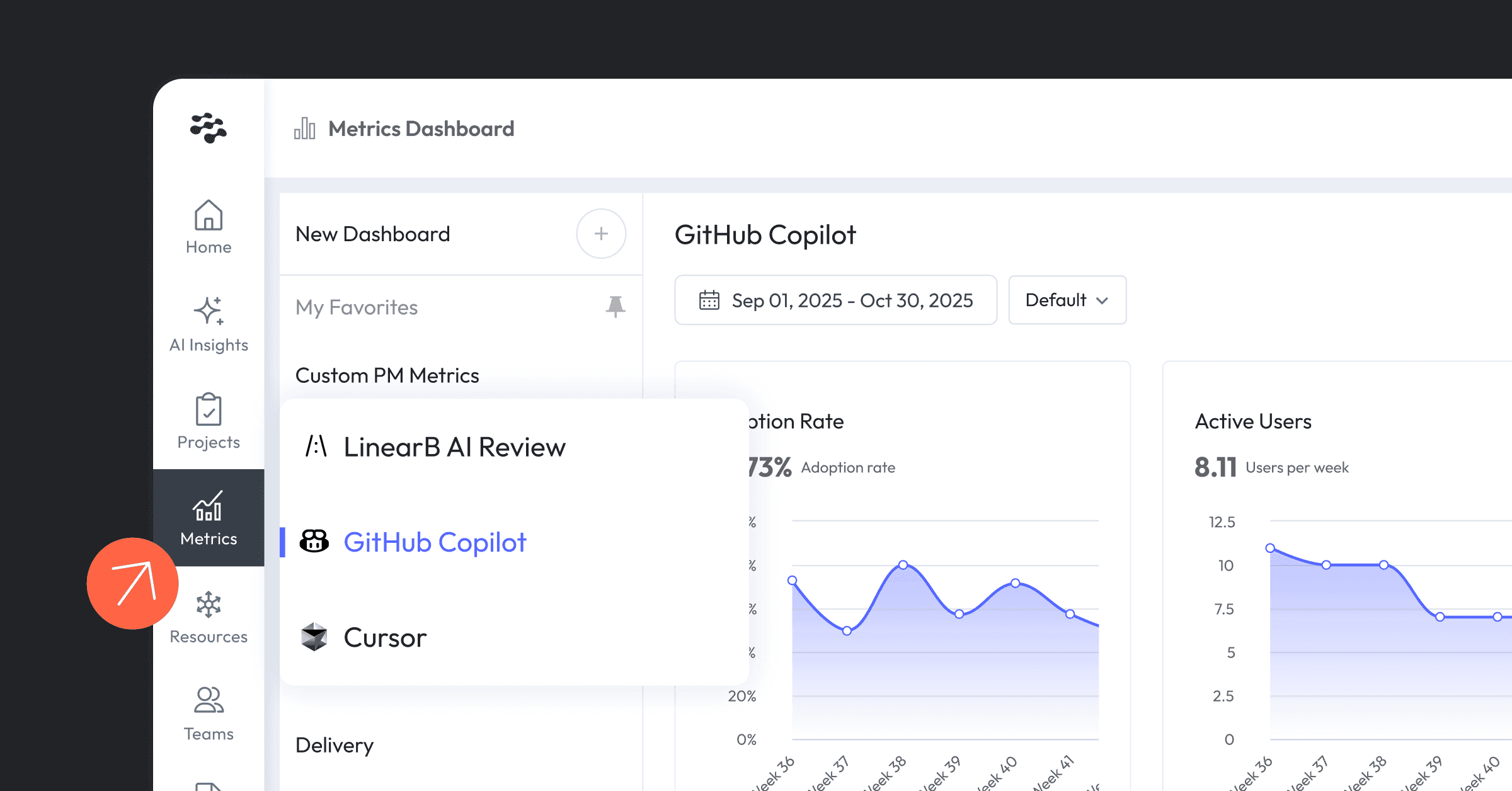When selecting a Software Engineering Intelligence Plus (SEI+) platform, engineering leaders face a critical decision. The right tool can streamline processes, enhance productivity, and align engineering efforts with business goals. In this comprehensive guide, we will compare Jellyfish vs. LinearB, two prominent SEI+ platforms, to help you determine which best aligns to your team's needs.
Understanding SEI+ Platforms
Jellyfish vs. LinearB: Best Tools for Engineering Analytics
When it comes to Jellyfish vs. LinearB, both tools aim to enhance software engineering operations by providing critical insights and metrics. However, their approaches and features cater to different aspects of engineering management.
Jellyfish focuses on aligning engineering work with business objectives by providing visibility into how engineering efforts impact company goals. It emphasizes project-level metrics and resource allocation to ensure that engineering teams are aligned with broader business strategies.
LinearB, a Jellyfish alternative, provides a comprehensive suite of tools designed to optimize developer experience (DevEx), improve productivity, and ensure predictable software delivery. With features like the WorkerB bot assistant, gitStream workflow automations, and various dashboards, LinearB aims to streamline code reviews, set team goals, and forecast project delivery.
Jellyfish vs. LinearB: Key Features and Capabilities
Jellyfish's Approach
Jellyfish is known for its focus on aligning engineering work with business objectives. It offers a range of features designed to provide visibility into engineering investments and their impact on organizational goals. Its core features include:
- Investment Tracking: Jellyfish allows teams to track investments in various projects and initiatives, offering detailed insights into resource allocation and financial commitment.
- Goal Setting: The platform supports setting and monitoring engineering goals, helping teams align their efforts with broader business objectives and ensure that engineering activities contribute directly to strategic aims.
- Reporting: Jellyfish provides advanced reporting capabilities that deliver comprehensive insights into engineering performance and investment impact, enabling data-driven decisions and better management of resources. These features collectively help organizations bridge the gap between engineering efforts and business outcomes.

How LinearB Does It
LinearB, a Jellyfish alternative, offers a broader range of features designed to improve developer experience and optimize various legs of the SDLC. Key features include:
- DevEx Metrics: LinearB provides detailed insights into developer experience, including a free DORA metrics offering, to track performance and identify areas for improvement.
- gitStream Workflow Automations: Automates code review routing and standardizes practices to enhance efficiency and reduce bottlenecks.
- Developer Coaching Dashboard: Aids engineering managers in understanding the impact of their developers and identifying growth opportunities.
- Resource Allocation: The platform provides insights into how resources are distributed across projects, enabling better planning and optimization.
- Project Forecasting Dashboards: Helps predict delivery timelines and uncover delivery risks in real time.

Jellyfish vs. LinearB: Recommendations for Choosing an SEI+ Platform
1. Jellyfish vs. LinearB: Assess Your Team's Needs and Goals
When evaluating Jellyfish vs. LinearB, it's crucial to consider how well each tool aligns with your team's specific objectives. Jellyfish excels in aligning engineering work with business goals, making it a strong candidate if your primary focus is on tracking investments and aligning with organizational objectives.
On the other hand, LinearB offers a broader range of features that cover various aspects of software engineering, from code reviews to project forecasting. This makes LinearB a compelling choice for a platform that provides comprehensive insights into developer experience and project management.

2. Jellyfish vs. LinearB: Prioritize Developer Experience
For engineering teams, enhancing developer experience and productivity is often a top priority. Regarding Jellyfish vs. LinearB – LinearB's DevEx metrics, including DORA metrics, offer valuable insights into developer performance and efficiency. Features like WorkerB Bot and gitStream workflow automation can significantly improve the speed and quality of code reviews, leading to better overall productivity.
Jellyfish provides valuable investment tracking and goal-setting features but lacks the in-depth focus on developer experience that LinearB offers. If optimizing developer workflows and improving productivity are central to your goals, LinearB may better meet your needs.

3. Jellyfish vs. LinearB: Evaluating Features for Productivity
For teams struggling with inefficient code review processes or bottlenecks, LinearB's gitStream workflow automations can offer significant improvements. Automating workflows and standardizing practices can lead to faster review cycles and smoother development processes.
With workflow automation, you can:
- Achieve shorter review cycles and faster PR pickup times with smart alerts.
- Get real-time pull request updates, including estimated review time, PR owner, and related issue links.
- Auto approve safe pull requests, create one-click JIRA tickets for undocumented PRs, and keep your processes lean.

4. Jellyfish vs. LinearB Cost and Value Analysis for Development Teams
LinearB offers a free plan that provides essential DORA insights and metrics, allowing teams to optimize their software delivery without upfront costs. This free tier includes features like cycle time and throughput analytics, aimed at improving productivity and efficiency.
Conversely, Jellyfish employs a more customized pricing model that often involves direct consultations to get a quote.

Jellyfish vs. LinearB: Making an Informed Decision
Choosing the right SEI+ platform is a critical decision that can impact your team’s efficiency, productivity, and alignment with business goals. By understanding the key features and benefits of Jellyfish vs. LinearB, you can make a more informed decision that aligns with your specific needs and objectives. Both Jellyfish and LinearB offer distinct features tailored to different needs. Jellyfish excels in aligning engineering work with business goals through investment tracking. LinearB, on the other hand, offers a robust free plan with essential DevOps metrics to optimize software delivery and enhance productivity.
For further insights into optimizing developer efficiency, check out our blog on scaling developer efficiency. If you're interested in the DORA metrics and how they can enhance your team's performance, our DORA metrics guide provides valuable information. Additionally, our article on team working agreements and resources on modern practices for goal-setting and engineering leader guide to goals and reporting offer further guidance for engineering leaders.
Investing in an SEI+ platform is a strategic decision that should align with your team’s goals and operational needs. By carefully evaluating the features and benefits of Jellyfish vs. LinearB, you can ensure that your investment supports your journey towards engineering excellence.




